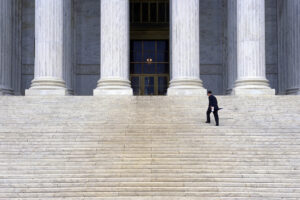This article is related to a Showcase CLE program at the ABA Business Law Section’s 2022 Hybrid Spring Meeting. To learn more about this topic, view the program as on-demand CLE, free for Section members.
Traditionally, corporations’ main risk factors were related to business and business environment, and the primary criterion for evaluating corporate action was maximizing shareholder welfare and return. Recently, a new set of risk criteria outside the traditional focus on financial performance is gaining prominence: environmental, social and governance (ESG) risk management. ESG risks are more than just reputational—they can include costly litigation, hefty fines, seizures at U.S. ports, debarment, bank insecurity, and plunging stock value. Bottom line: ESG risks can stop or seriously delay company operations.
On March 31, a panel discussion at the American Bar Association Business Law Section Hybrid Spring Meeting will consider the evolution of ESG concerns and reporting, from philanthropic and discretionary corporate social responsibility (CSR) acts to required disclosure and regulatory focus as an inherent part of valuation. The breadth of shareholder proposals related to ESG and the importance of board governance and oversight will be discussed, along with the need for robust internal ESG governance processes for assessing materiality. The panelists will examine ESG risks through the eyes of not only major company or financial institution general counsel or senior in-house and outside counsel, but also of a diverse group of professionals in this area from several perspectives, including the founder and president of a leading human rights litigation advocacy group. These perspectives include:
- Regulatory activity regarding climate risk within the financial services sector, including expectations of the Office of the Comptroller of the Currency and the Federal Reserve Board. In addressing climate risk, financial institutions must analyze physical risk (e.g., the risk associated with the direct impact of climate change on institutions’ physical assets and the physical assets of their borrowers); transition risk (e.g., the risk associated with increased market demand for lower carbon–producing products and services); acute risks (e.g., the risks associated with a specific short-term climate event, such as a natural disaster); and chronic risks (e.g., the risks associated with the increase in frequency of natural disasters over time). The panelists will provide an overview of recent developments and discuss the practical implications for financial institutions and their customers.
- Litigation risks for companies as well as board members and officers, whether from regulatory agencies, private plaintiffs, or public interest organizations. Discussion also will include the status of strategic litigation in the human rights arena; other mechanisms underway that can disrupt labor trafficking, such as the Trade Facilitation and Trade Enforcement Act and the Federal Acquisition Regulation; trends in the litigation arena; and the status of extraterritorial application in human rights cases.
- Risks springing from the draft E.U. Directive requiring human rights due diligence and remediation of adverse impact issues in supply chain management, and specific contract assurances addressing such human rights initiatives, including the concept of shared responsibility. Recently, shared responsibility was addressed in a unique buyer code of conduct found in Version 2.0 of the Model Contract Clauses to Protect Human Rights in International Supply Chains (the MCCs), which incorporate the UN Guiding Principles on Business and Human Rights (UNGPs) and the Organisation for Economic Co-operation and Development (OECD) guidelines and are drawn from the ABA Model Principles on Labor Trafficking and Child Labor. Published in the Winter 2021–2022 issue of The Business Lawyer, the MCCs integrate human rights due diligence into every stage of the supply chain contract, allow enforcement by every buyer and supplier in the chain (eliminating conventional privity of contract), and prioritize remediation of human rights harms over conventional contract remedies.
- Other newly manifest risks that have surfaced in recent years.
The program will emphasize how companies, banks, investors, and advisors take legal risks all the time, but often fail to integrate these risks effectively in an environment that is changing continuously. Those who ignore these and other ESG risks do so at their peril and miss the chance to create long-term value as advocated by BlackRock CEO Larry Fink in his last few annual CEO letters. As the demand for data and transparency with respect to ESG factors increases, the need to break down silos and be sure legal oversight is truly integrated with an organization’s compliance and operations is the only way to create an effective overall enterprise risk strategy. We will also discuss essential, practical tools for measuring, monitoring, and proactively managing a variety of ESG risks and provide ample materials for future reference.
There can be no question that the role of legal counsel is expanding into a proactive role in an organization’s broader enterprise governance, risk management, and compliance (GRC) strategy. The ever-increasing ESG initiatives impacting many aspects of business are evidenced, in part, by the number of ESG-related CLEs at the upcoming Business Law Section Hybrid Spring Meeting. The objective of all these ESG-related CLE programs, listed below, is to be sure business lawyers have the tools to assist clients in coordinated efforts to act with integrity in fulfilling legislative, regulatory, contractual, and even self-imposed obligations.
The Myriad Approaches to ESG Data and How to Use Your Data to Report Reliably on March 31, 2:00–3:30 p.m. ET, from the Legal Analytics, Cyberspace Law, International Business, International Coordinating, and Sports Law Committees
The Future of Commercial Office Space in Hybrid Workplace and Its Impact on Lenders, March 31, 4:00–5:00 p.m. ET, from the Banking Law, International Business, International Coordinating and Legal Analytics Committees
Equity, Equality, Regulation and Enforcement: The Evolving Regulatory Landscape of Fair Lending Redlining and UDAAP, April 1, 8:00–9:00 a.m. ET, from the Banking Law and Credit Union Committees
Current State of the Syndicated Loan Market, April 1, 10:00–11:30 a.m. ET, from the Commercial Finance and Uniform Commercial Code Committees
Understanding the Elements of ESG and Current DOL Guidance on ESG in Plan Investments, April 1, 2:00–3:00 p.m. ET, from the Employee Benefits and Executive Compensation and Corporate Social Responsibility Law Committees
ESG in the Board Room: Counseling Directors on ESG, April 1, 4:00–5:00 p.m. ET, from the Federal Regulation of Securities, Corporate Social Responsibility Law, Corporate Governance, International Business Law and International Coordinating Committees

















